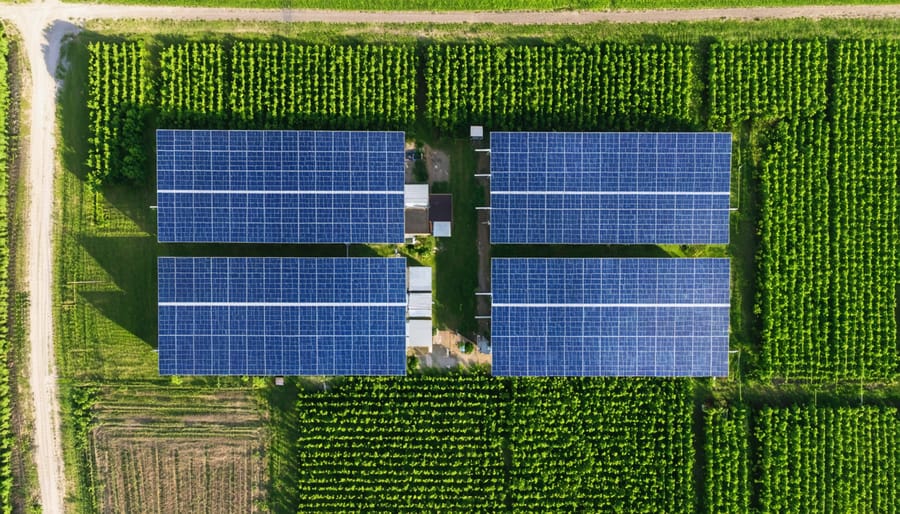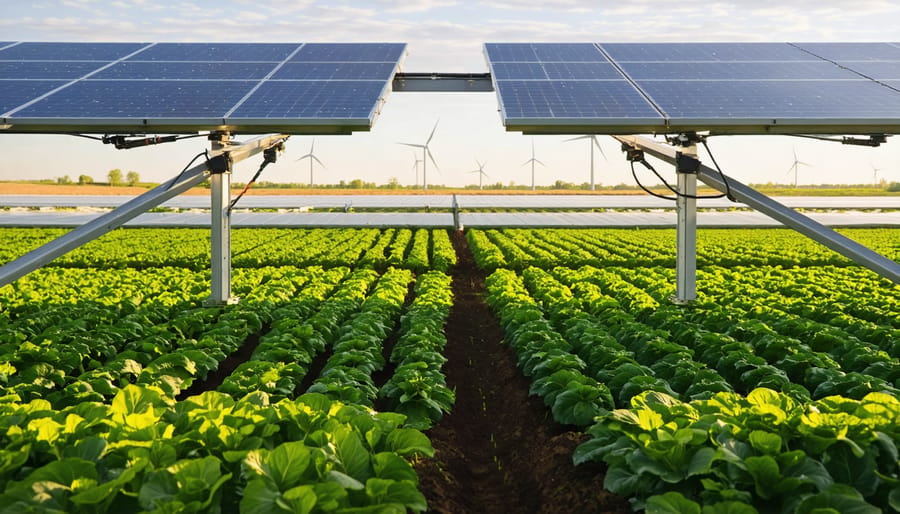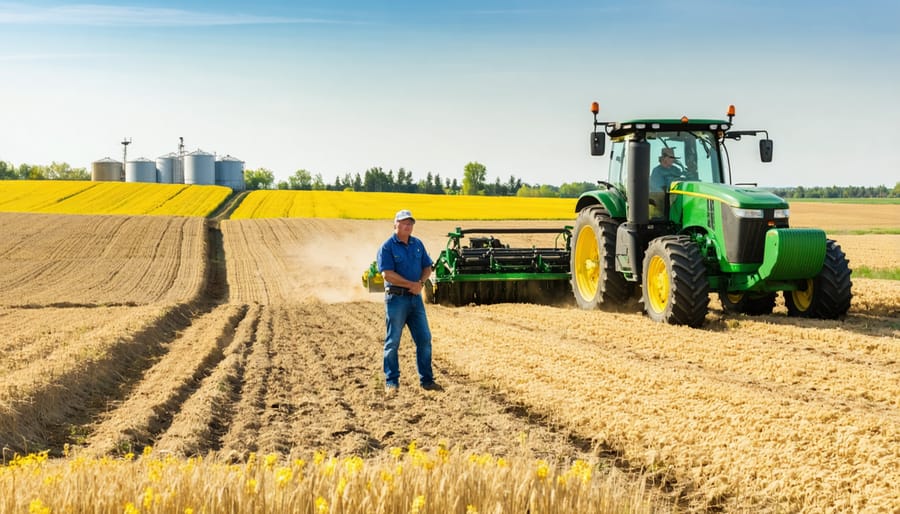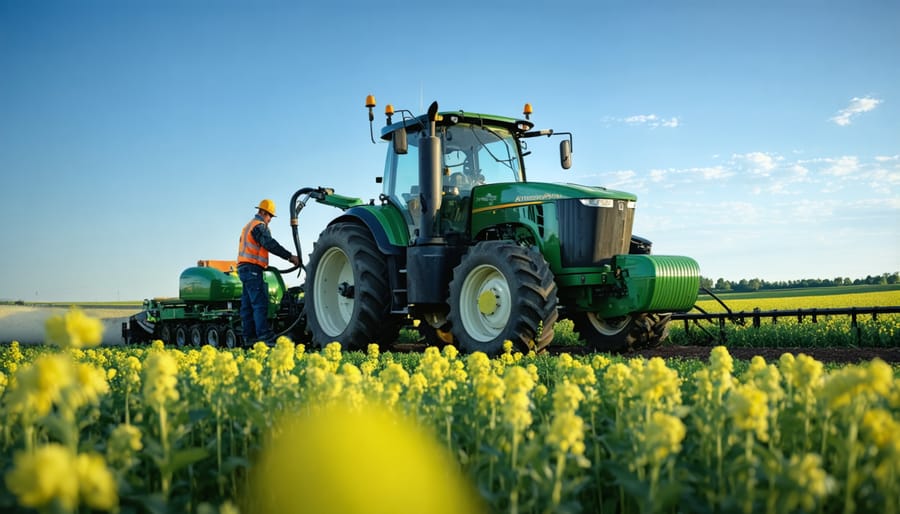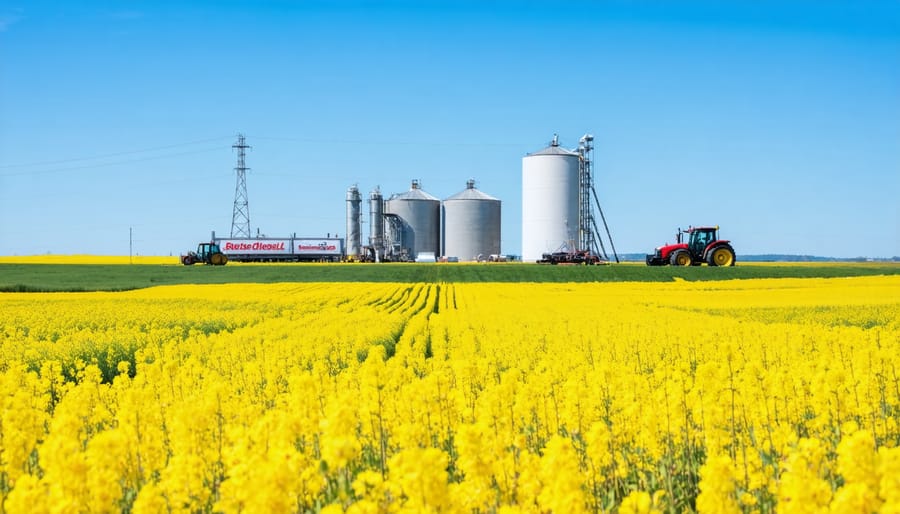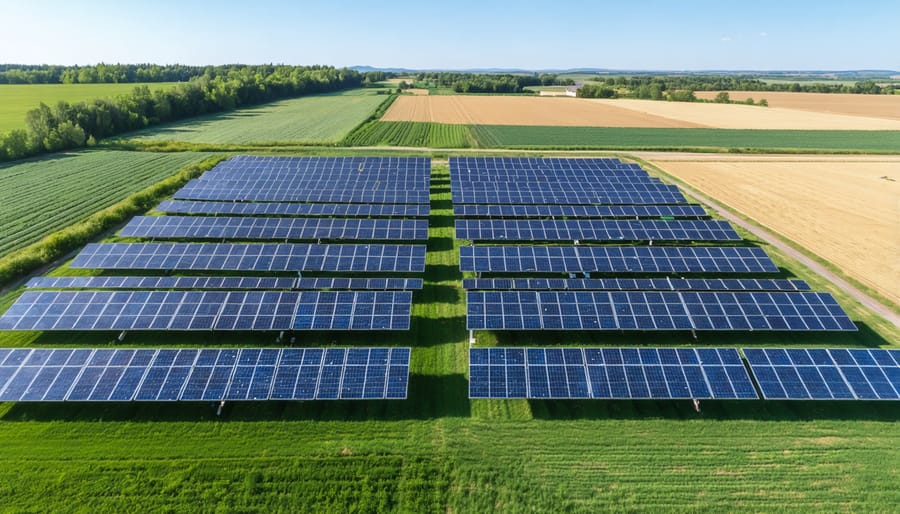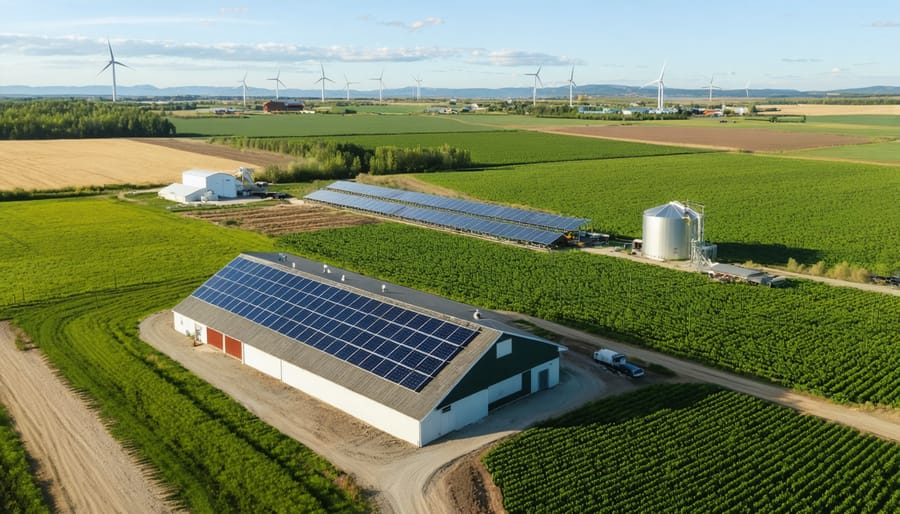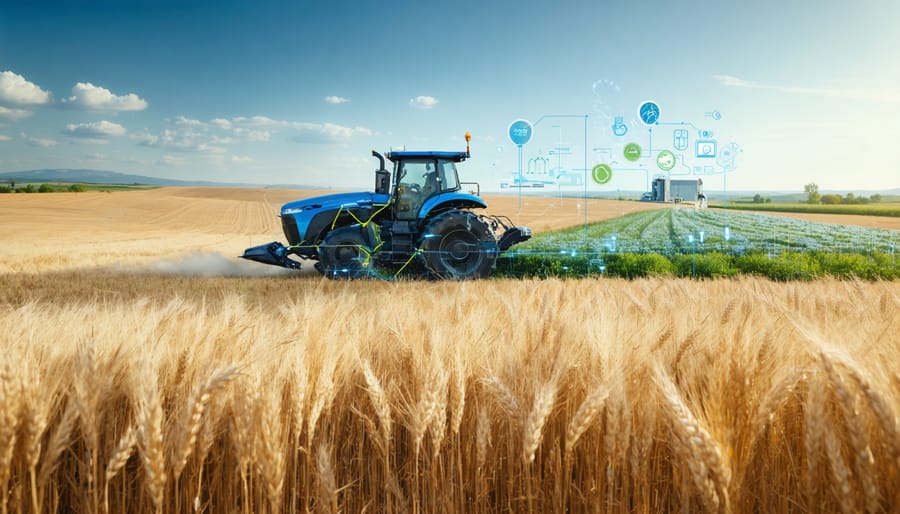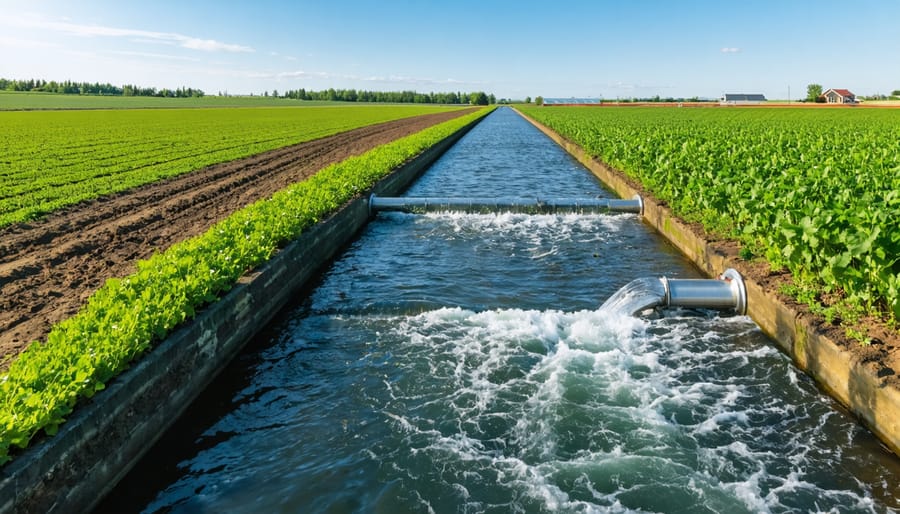Transforming Canadian farms into renewable energy powerhouses isn’t just about environmental stewardship—it’s about securing our agricultural future. Today’s farmers across Alberta and beyond are pioneering innovative approaches to solar integration in agriculture, reducing operational costs by up to 75% while maintaining crop yields. From wind-powered irrigation systems serving 160-acre plots to biomass digesters converting agricultural waste into electricity, renewable energy is revolutionizing how we grow food.
Recent data from Agriculture Canada shows that farms implementing renewable energy systems save an average of $45,000 annually on energy costs. These systems not only buffer against rising utility prices but also create new revenue streams through grid feed-in programs. For Alberta farmers specifically, the combination of abundant solar resources and supportive provincial incentives has made renewable energy integration particularly attractive, with payback periods averaging 5-7 years.
By embracing these technologies, Canadian farmers aren’t just reducing their carbon footprint—they’re building more resilient, profitable operations that can weather future challenges while contributing to Canada’s clean energy goals.
The Perfect Match: Renewable Energy Systems for Organic Farms
Solar Solutions for Year-Round Operations
Solar power has become a game-changer for Canadian farms seeking year-round operational efficiency. Through innovative agrivoltaics, farmers are discovering ways to maximize land use by combining solar installations with crop production.
For greenhouse operations, solar panels provide reliable power for climate control systems, enabling consistent growing conditions throughout Alberta’s challenging seasons. Many farmers have installed solar-powered ventilation and heating systems, reducing energy costs by up to 60% while maintaining optimal growing environments.
Irrigation systems powered by solar energy offer particular benefits for remote field operations. Solar-powered pumps can deliver water efficiently across large areas without relying on grid electricity or diesel generators. These systems are especially valuable during peak growing seasons when traditional power sources might be strained or costly.
Equipment charging stations powered by solar arrays are becoming increasingly common on Canadian farms. Electric tractors, UTVs, and other farm equipment can be charged during daylight hours, ensuring they’re ready for use when needed. The Petersens, who farm near Red Deer, report saving approximately $4,000 annually on fuel costs since installing their solar charging station.
Local success stories show that initial investment in solar infrastructure typically pays for itself within 5-7 years through reduced operational costs. With available federal and provincial grants covering up to 30% of installation costs, more Alberta farmers are finding solar solutions increasingly accessible and economically viable.
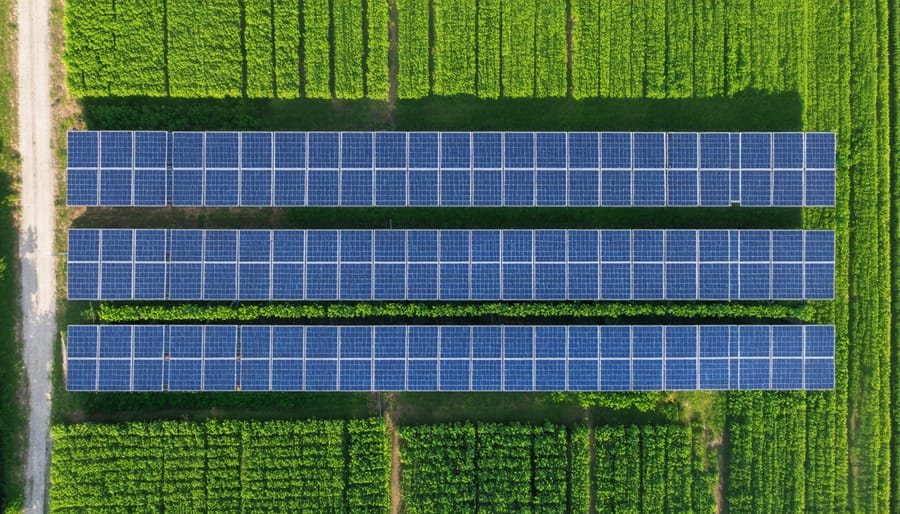
Wind Energy: Powering the Prairie Farm
Alberta’s expansive prairies offer ideal conditions for harnessing wind energy, with average wind speeds of 6-8 metres per second in many agricultural regions. For farmers looking to diversify their income and reduce operational costs, wind energy presents a compelling opportunity.
Take the case of Sarah Thompson, a third-generation farmer near Pincher Creek, who installed two 80-kilowatt turbines on her property in 2019. “The turbines now power our entire irrigation system and grain storage facilities,” she explains. “Our electricity bills have dropped by 70%, and we’re selling excess power back to the grid.”
The initial investment for farm-scale wind systems typically ranges from $50,000 to $200,000, depending on capacity needs. However, Alberta’s Growing Forward 3 program offers grants covering up to 30% of installation costs. Local utility companies also provide net metering programs, allowing farmers to offset their energy costs through power generation credits.
Before installation, farmers should conduct a wind resource assessment, typically lasting 12 months, to determine optimal turbine placement. Working with certified installers familiar with agricultural applications is crucial for maximizing efficiency and ensuring proper integration with existing farm operations.
The Prairie Wind Energy Cooperative, a farmer-led initiative in Southern Alberta, offers peer support and bulk purchasing options, making wind energy more accessible to small and medium-sized farms. Their mentorship program connects experienced wind energy users with farmers considering installation.
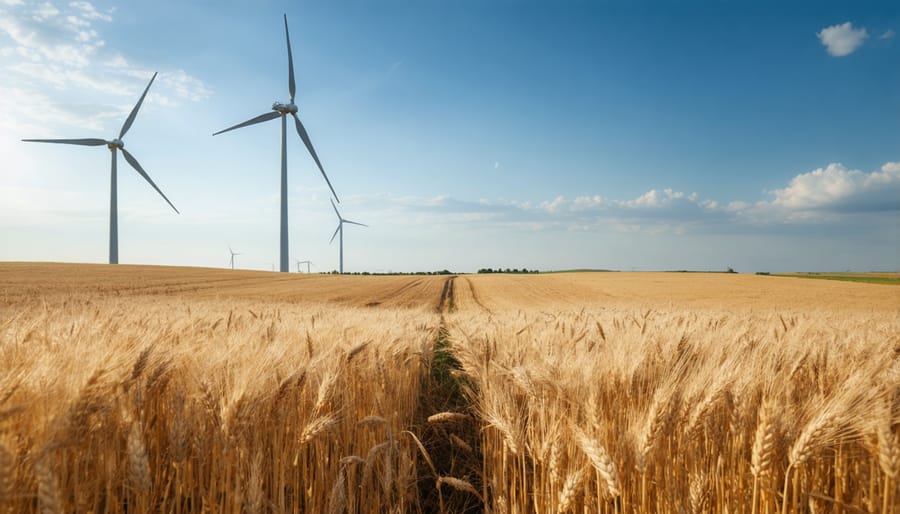
Real Results: Alberta Success Stories
The Thompson Family Farm Transformation
Located just outside of Olds, Alberta, the Thompson Family Farm has become a shining example of combining solar power with crop production. Sarah and Mike Thompson, third-generation farmers, transformed their 40-hectare organic vegetable operation into a model of sustainable agriculture in 2019.
The Thompsons installed a 200-kilowatt solar array system, carefully positioned to maximize both energy generation and crop yields. Their innovative design includes elevated panels mounted 3 metres above the ground, allowing tractors to pass underneath while creating partially shaded areas that benefit heat-sensitive crops like lettuce and spinach.
The initial investment of $425,000 was offset by a $150,000 grant from Alberta’s On-Farm Solar PV Program. The system now generates enough electricity to power their entire operation, including cold storage facilities and irrigation systems, with surplus energy being fed back into the grid.
“We’re saving approximately $2,000 per month on electricity costs,” shares Sarah Thompson. “But the benefits go beyond financial savings. Our shade-loving crops have shown a 15% increase in yield, and we’ve reduced our water usage by 30% due to decreased evaporation under the panels.”
The success of their project has attracted attention from neighbouring farms, with the Thompsons hosting regular tours and workshops for local farmers interested in renewable energy integration. They’ve also partnered with Olds College to provide hands-on learning opportunities for agricultural students studying sustainable farming practices.
Through careful planning and implementation, the Thompsons have demonstrated that renewable energy can enhance both environmental sustainability and farm profitability in the Canadian agricultural sector.
Mountain View Organics’ Energy Revolution
Located just outside of Olds, Alberta, Mountain View Organics has transformed their 800-hectare mixed farming operation into a model of renewable energy integration. Owner Sarah Thompson, a third-generation farmer, implemented a diverse energy strategy that’s yielding impressive results both environmentally and economically.
“We started small in 2018 with a 10kW solar array on our main barn,” explains Thompson. “The success of that initial investment encouraged us to expand our renewable portfolio significantly.” Today, the farm operates with a comprehensive 75kW solar system, two small-scale wind turbines, and a biogas digester that converts agricultural waste into usable energy.
The farm’s renewable systems now generate 90% of their total energy needs, powering everything from irrigation systems to grain drying operations. The biogas digester alone processes 2,000 tonnes of organic waste annually, producing enough energy to heat their greenhouse operations throughout Alberta’s cold winters.
Thompson’s implementation strategy focused on gradual expansion, allowing for careful monitoring of each system’s performance. “We worked closely with local renewable energy consultants and took advantage of Alberta’s On-Farm Energy Management Program, which covered 50% of our initial assessment costs,” she notes.
The farm’s annual energy costs have decreased by $45,000, with an expected return on investment within eight years. Beyond the financial benefits, Mountain View Organics has reduced their carbon emissions by 85 tonnes annually, contributing to their organic certification requirements and environmental stewardship goals.
Thompson regularly hosts farm tours for neighbouring agricultural operations, sharing practical insights about renewable energy integration in Canadian farming contexts. “It’s about showing others that sustainable energy isn’t just environmentally responsible—it’s financially smart farming,” she concludes.
Getting Started: Practical Implementation Steps

Assessment and Planning
Before implementing renewable energy solutions on your farm, conducting a thorough assessment of your current energy needs and future goals is essential. Start by performing an energy audit, which involves tracking your monthly energy consumption patterns across different seasons and identifying peak usage periods. Many Alberta agricultural extension offices offer free or subsidized energy audit services to help you gather accurate data.
Consider your farm’s unique characteristics, including available resources like solar exposure, wind patterns, and biomass potential. Local meteorological data can provide valuable insights into these factors. Remember to account for seasonal variations and how they might affect your energy generation capacity throughout the year.
When evaluating the benefits of solar power investment and other renewable options, create a detailed cost-benefit analysis. Factor in initial installation costs, available government incentives, maintenance requirements, and projected energy savings over time. The Canadian Agricultural Partnership (CAP) program offers various funding opportunities that can help offset implementation costs.
Develop a phased implementation plan that aligns with your farm’s budget and operational schedule. Consider starting with smaller projects to test effectiveness and build confidence before scaling up. Many successful Alberta farmers have found that beginning with energy efficiency improvements, such as LED lighting or smart controls, provides immediate returns while planning larger renewable energy installations.
Consult with local renewable energy contractors who understand agricultural applications and regional conditions. They can help assess your site’s specific requirements and recommend appropriate system sizes and configurations. Remember to verify their credentials and experience with similar agricultural installations in your area.
Available Grants and Support
Canadian farmers looking to transition to renewable energy have access to numerous support programs and funding opportunities. The Canadian Agricultural Partnership (CAP) offers grants of up to $50,000 for implementing sustainable energy solutions, including solar panels, wind turbines, and biogas systems.
In Alberta, the Farm Energy and Agri-Processing Program (FEAP) provides cost-sharing grants covering up to 50% of eligible expenses for energy efficiency and renewable energy projects. Farmers can receive between $25,000 to $250,000 depending on project scope and environmental impact.
The Agriculture Financial Services Corporation (AFSC) offers low-interest loans specifically designed for renewable energy installations. These loans feature flexible repayment terms and competitive interest rates, making the initial investment more manageable for farm operations of all sizes.
Technical support is readily available through Alberta Agriculture and Forestry’s Energy Extension Program. Their energy specialists provide free consultations, feasibility studies, and guidance throughout the project implementation process.
Additional resources include the Municipal Climate Change Action Centre (MCCAC), which offers specialized programs for agricultural operations in participating municipalities. Their Agriculture Energy Savings Program provides energy audits and implementation support at reduced costs.
For organic farmers, the Canada Organic Trade Association maintains a database of grants specifically targeting sustainable agriculture practices, including renewable energy integration. The Environmental Farm Plan (EFP) program also offers technical assistance and funding opportunities for farms implementing environmentally sustainable practices.
Remember to consult with local agricultural extension offices and renewable energy associations for the most current funding opportunities, as programs and eligibility requirements are regularly updated.
Installation and Maintenance Best Practices
Proper installation and maintenance of renewable energy systems are crucial for their long-term success on your farm. We recommend working with certified installers who understand Alberta’s unique climate conditions and agricultural needs. Before installation, conduct a thorough site assessment to determine optimal placement for solar panels or wind turbines, considering factors like shade patterns, wind exposure, and proximity to existing infrastructure.
For solar installations, ensure your mounting systems can withstand our harsh prairie winds and heavy snow loads. Position panels at a 45-degree angle for optimal year-round performance in Alberta’s latitude. Install monitoring systems to track performance and quickly identify any issues that arise.
Regular maintenance is straightforward but essential. Clean solar panels twice yearly, typically in spring after snow melt and fall before winter sets in. Use soft brushes and non-abrasive cleaners to prevent damage to panel surfaces. For wind systems, schedule annual inspections of turbine blades, bearings, and electrical connections.
Keep detailed maintenance records and set up a regular inspection schedule. Many Alberta farmers find success with quarterly checks of all system components. During harvest season, pay extra attention to dust accumulation on solar panels, as this can significantly impact efficiency.
Consider joining local renewable energy cooperatives or farmer networks to share maintenance tips and resources. Many successful installations in our region have benefited from community knowledge-sharing and collective problem-solving approaches.
The transition to renewable energy in agriculture represents a significant opportunity for Canadian farmers to build more sustainable and profitable operations. Through the implementation of solar panels, wind turbines, and biomass systems, farmers across Alberta are already seeing substantial reductions in their energy costs while contributing to environmental conservation.
The benefits extend beyond individual farms to strengthen entire rural communities. From increased energy independence to new revenue streams through power generation, renewable energy adoption creates lasting positive impacts for current and future generations of agricultural producers.
Your journey toward renewable energy integration doesn’t have to be a solo endeavour. Alberta’s agricultural community offers robust support networks, including the Agricultural Solar Program and various regional farming associations that provide guidance, resources, and funding opportunities. Local success stories, like the McDougall family farm in Olds that reduced their annual energy costs by 65% through solar installation, demonstrate what’s possible with proper planning and community support.
We encourage you to take the first step by connecting with your local agricultural extension office or renewable energy consultant. Together, we can build a more sustainable and prosperous future for Canadian agriculture. Whether you’re considering a small-scale solar installation or a comprehensive renewable energy system, the resources and expertise you need are available right here in our farming community.
Remember, every sustainable choice we make today helps secure our agricultural heritage for tomorrow. Let’s work together to harness the power of renewable energy for a stronger, more resilient farming future.

